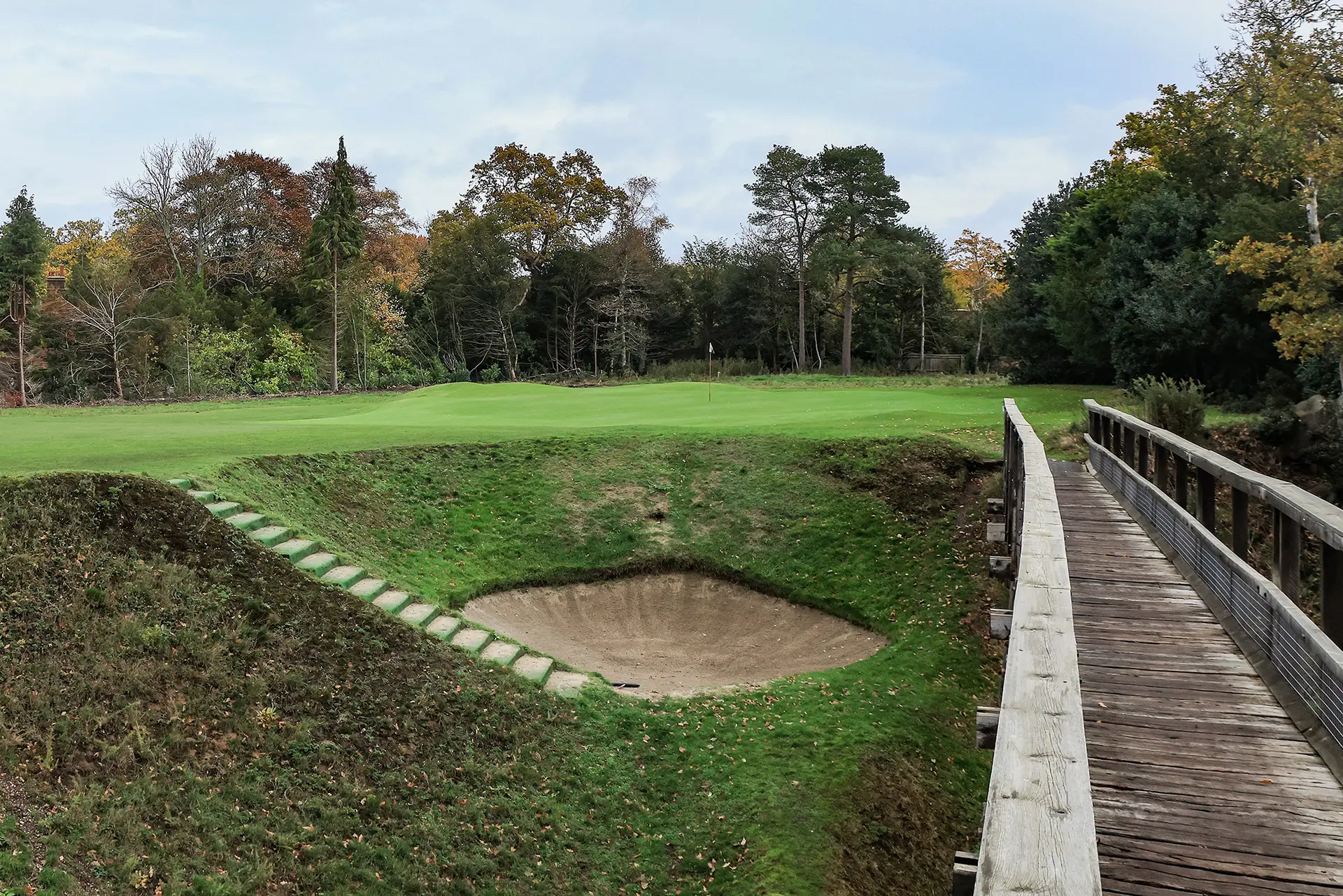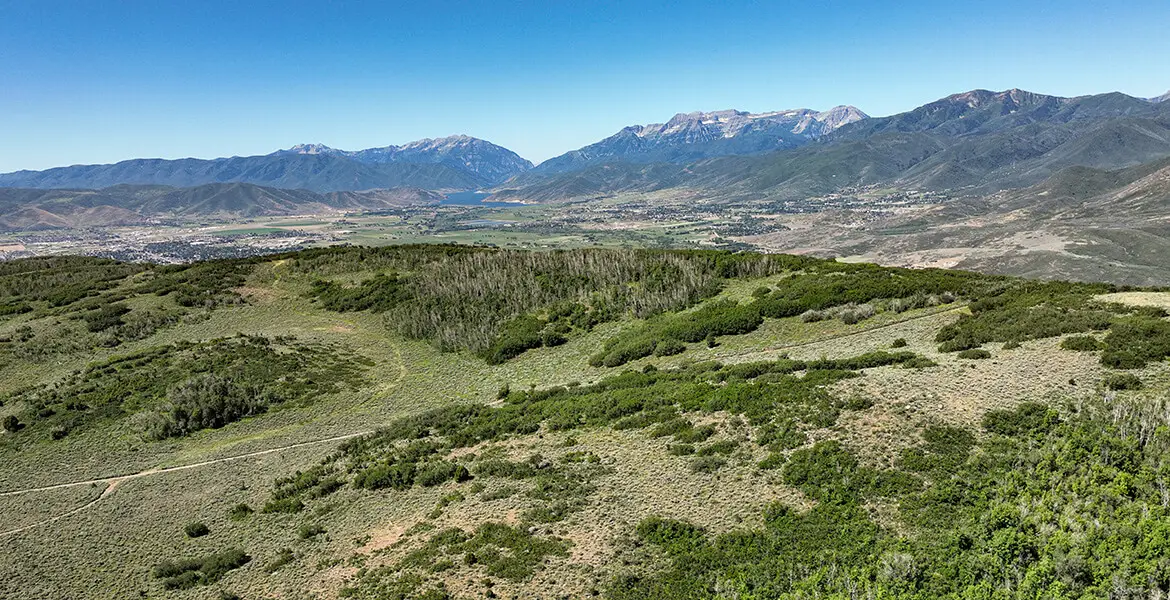They might not be built in today’s world because of cost, maintenance, playability, or safety concerns, but some of golf’s most famous and extravagant bunkers are retained and restored because of their special place in the game. They give a course character, identity, and a charm that make them entirely worthy of keeping.
Scottish-based architect Clyde Johnson, an associate and mentee of Tom Doak and a highly respected shaper and engineer with his own design firm (Cunnin’ Golf Design) recently restored the intimidating Himalaya Bunker on the 6th hole at St. Enodoc in southwest England, carrying out a long-awaited project that Doak (a huge fan of the course) had suggested in 2016.
Though recognized as a bunker, the hazard was originally a huge sand scar atop a mighty dune that gradually became more formalized over time. Old photographs show how much it has evolved during a century-plus of play, upkeep, and weather with a second, much smaller bunker (probably a remnant of the mother bunker’s tail) appearing to its left at some point in the last quarter of the 20th century.
It was felt the smaller bunker had served its purpose (whatever that was) for long enough and had to go. The Himalaya, meanwhile, would be given the love and attention it badly needed.
“The real impetus for restoring the bunker was that it had lost its former glory,” Johnson says. Some work was done in 2021 but not extensively. This time, Johnson wanted to establish the balance of creativity and pragmatism Doak had always spoken of.
“The aim was to reestablish some of the bunker’s tail and make it look ‘raw,’ almost crude, while simultaneously eliminating the left bunker, improving turf conditions, and providing 10–15 yards of additional space for walking golfers,” says Johnson, who has also rebuilt the Lamb Bunker to the left of the green at North Berwick’s famous Redan (15th hole) within the last couple of years. The goal there, much like at St. Enodoc, was to increase the bunker’s dimensions and restore the feature’s visual menace. “We’ve been recapturing the scale of the hole’s original bunkers over the last four years,” says Johnson. “The Lamb bunker was in a bit of state and had become a slender and rather meek-looking trench whose floor tilted hard towards the face, making it very difficult for any golfer to get out.”

Johnson raised the bunker floor and let the face climb toward the revetted wall, as it did decades ago. The six-foot, near-vertical wall was also restored to its position tighter to the edge of the green, making it altogether scarier and a place you really don’t want to go.
Another UK bunker into which no one has ever wanted to go in is the 40-foot-high monster, also called Himalaya, on the 4th hole at Royal St. George’s, which was repaired and restored by Martin Ebert about 10 years ago. Ebert first worked on the Open Championship venue with Donald Steel at the start of the century and has been consulting at the club with partner Tom Mackenzie since 2025.
The work on that Himalaya bunker was motivated partly by a desire to make it look more natural—over 90 sleepers were added to the rim prior to the 1993 Open Championship in order to stabilize it (the smaller, but still imposing, bunker to the left had been sleepered before the ’85 Open) but also to make it safer as the railroad ties were shifting into potentially hazardous positions. “Over the years, they had become a danger as they’d started to lean back from vertical and there was a possibility they might collapse,” says Ebert. “The bunker was therefore taken out of play and the area deemed GUR with no access allowed to the sand.”
The decision was made to restore both bunkers to their rough-edged state. Sand blown by the wind had also caused the face of the larger bunker to rise so it was lowered to assist with shaping the area.
Ebert’s work on the gargantuan “Pandy” bunker/waste area—originally a working sand pit when the course first opened—between the 17th and 18th holes at Ganton in North Yorkshire, England, was likewise extremely successful. “When Tom and I first consulted at the club in 2010, it had become overgrown with gorse and brush,” says Ebert. “Some clearance work was underway, but we submitted a report in 2012 that recommended it be restored as a great playing and landscape feature.” The project began in 2017 and continued for a number of years with a sleeper walkway being added.
Another great British bunker soon to be restored sits short and right of the green on the 6th hole at The Addington in south London. The great humorist, P.G. Wodehouse, was in it so often he instructed those wanting to contact him to send a note “C/O PGW, the 6th hole bunker at The Addington,” and said it was the “chasm from which no 18-handicap player has ever emerged within the memory of man.” Mike Clayton, Mike DeVries, and Frank Pont (CDP) are currently deciding how best to shape it and its surrounding hollow which they wish to be more visible from the fairway.

In the U.S., one of the best-known bunkers to revert to its original dimensions in recent years is the hazard encircling the par-three 4th green on the West course at the Donald Ross-designed Belleair Country Club in Florida. Restored by Dana Fry and Jason Straka in 2022, the hole had become a rather blah version of its former self and needed Connor Lewis, founder of The Society of Golf Historians in 2018, to provide some fervent enthusiasm if it was ever to be revived. “I gave the members an hour-long PowerPoint trying to convince them why Ross’s brilliant design should be reinstated,” Lewis says. “I think they agreed in the end just so I’d stop talking. The hole had become a total mess with numerous architects making changes over the decades.” Straka cleverly removed the lip from one section of the bunker allowing more seasoned members, without the clubhead speed to loft a ball on to the green, to putt the ball out if necessary.
Another famous American bunker to have been restored in 2022 is A.W. Tillinghast’s Great Hazard at the 17th hole on Baltusrol’s Lower course. Intended to require a couple of great strikes if players were to get anywhere near the green at the long par five (now 655 yards) in two, the hole featured a huge cross-bunker, neutered by modern equipment. So, Gil Hanse pushed the feature 60 yards farther down the hole, bringing it back into play for ambitious golfers. Hanse also altered the Church Pews bunker between Oakmont’s 3rd and 4th holes in 2024, adding a pew and some length to keep up with equipment.

Not as recent perhaps, but significantly more impactful, was what superintendent Graeme Grant did to the 15th hole at Kingston Heath in Melbourne, Australia, sometime in the 1980s. An eye-popping network of bunkers were added to the par three following Alister MacKenzie’s visit in 1926. “I’ve always assumed Mick Morcom, the superintendent at Royal Melbourne, built them all,” says Mike Clayton. “But they were removed in the ’70s, destroying the hole. Grant made it great again.”
They may not have become bad, necessarily, but restoring famous bunkers has made a lot of the game’s best holes great again.






